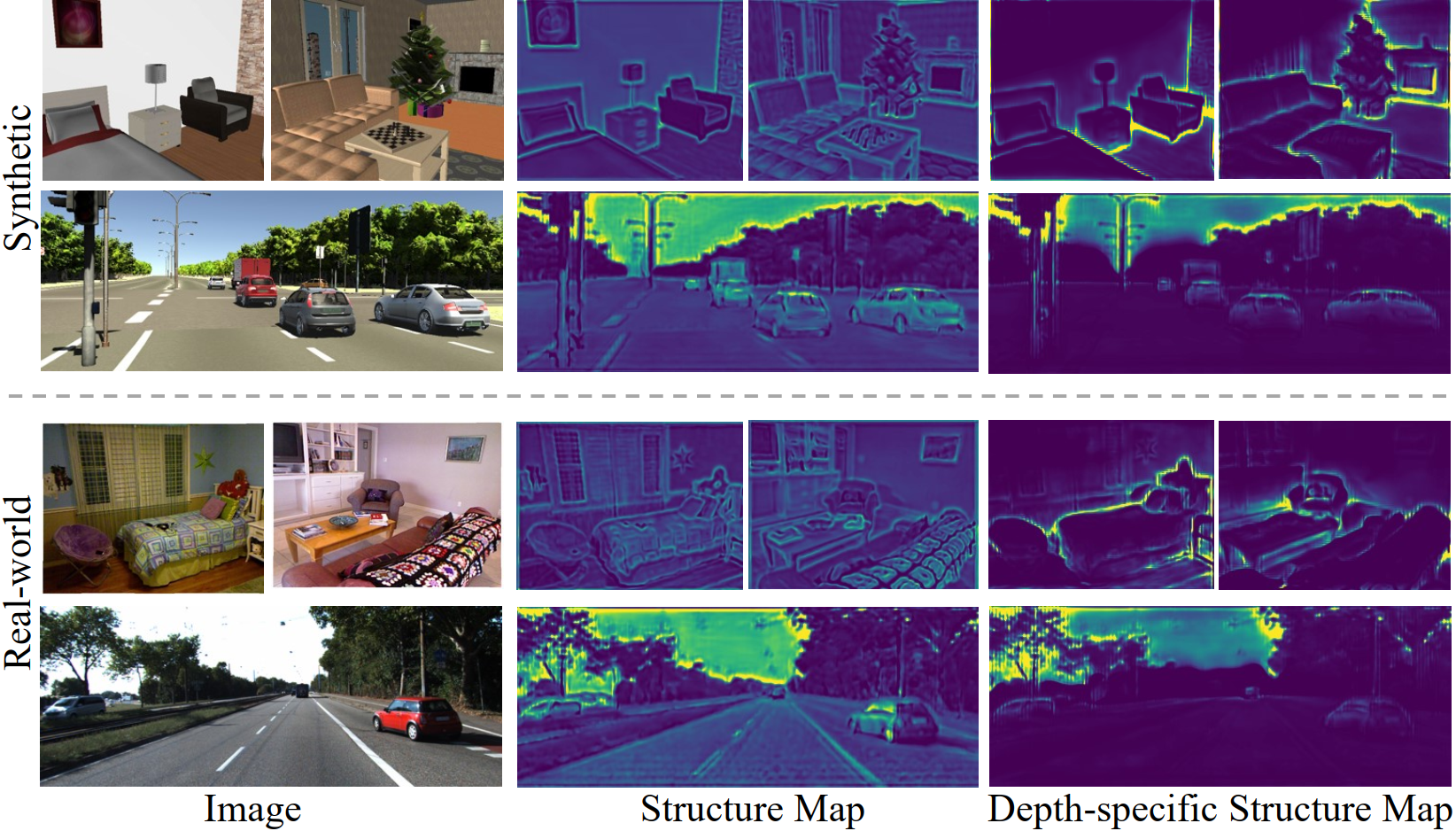This is the official PyTorch implementation of the paper S2R-DepthNet: Learning a Generalizable Depth-specific Structural Representation, CVPR 2021 (Oral), Xiaotian Chen, Yuwang Wang, Xuejin Chen, and Wenjun Zeng.
@inproceedings{Chen2021S2R-DepthNet,
title = {S2R-DepthNet: Learning a Generalizable Depth-specific Structural Representation},
author = {Chen, Xiaotian and Wang , Yuwang and Chen, Xuejin and Zeng, Wenjun},
conference={IEEE/CVF Conference on Computer Vision and Pattern Recognition (CVPR)},
year = {2021}
}
Human can infer the 3D geometry of a scene from a sketch instead of a realistic image, which indicates that the spatial structure plays a fundamental role in understanding the depth of scenes. We are the first to explore the learning of a depth-specific structural representation, which captures the essential feature for depth estimation and ignores irrelevant style information. Our S2R-DepthNet (Synthetic to Real DepthNet) can be well generalized to unseen real-world data directly even though it is only trained on synthetic data. S2R-DepthNet consists of: a) a Structure Extraction (STE) module which extracts a domaininvariant structural representation from an image by disentangling the image into domain-invariant structure and domain-specific style components, b) a Depth-specific Attention (DSA) module, which learns task-specific knowledge to suppress depth-irrelevant structures for better depth estimation and generalization, and c) a depth prediction module (DP) to predict depth from the depth-specific representation. Without access of any real-world images, our method even outperforms the state-of-the-art unsupervised domain adaptation methods which use real-world images of the target domain for training. In addition, when using a small amount of labeled real-world data, we achieve the state-of-the-art performance under the semi-supervised setting.
- Python3.6.9
- PyTorch(1.7.1)
- torchvision(0.8.2+cu101)
- TensorboardX(2.1)
- matplotlib(3.3.4)
- Pillow(8.1.2)
The outdoor Synthetic Dataset is vKITTI and outdoor Real dataset is KITTI
- Trianing Structure Encoder
We also provide our trained models for inference(outdoor and indoor scenes). Models Link
As an example, use the following command to train S2RDepthNet on vKITTI.
python train.py --syn_dataset VKITTI \
--syn_root "the path of vKITTI dataset" \
--syn_train_datafile datasets/vkitti/train.txt \
--batchSize 32 \
--loadSize 192 640 \
--Shared_Struct_Encoder_path "the path of pretrained Struct encoder(.pth)" \
--train_stage TrainStructDecoder
python train.py --syn_dataset VKITTI \
--syn_root "the path of vKITTI dataset" \
--syn_train_datafile datasets/vkitti/train.txt \
--batchSize 32 \
--loadSize 192 640 \
--Shared_Struct_Encoder_path "the path of pretrained Struct encoder(.pth)" \
--Struct_Decoder_path "the path of pretrained Structure decoder(.pth)" \
--train_stage TrainDSAandDPModule
Use the following command to evaluate the trained S2RDepthNet on KITTI test data.
python test.py --dataset KITTI --root "the path of kitti dataset" --test_datafile datasets/kitti/test.txt --loadSize 192 640 --Shared_Struct_Encoder_path "the path of pretrained Struct encoder(.pth)" --Struct_Decoder_path "the path of pretrained Structure decoder(.pth)" --DSAModle_path "the path of pretrained DSAModle(.pth)" --DepthNet_path "the path of pretrained DepthNet(.pth)" --out_dir "Path to save results"
Use the following command to evaluate the trained S2RDepthNet on NYUD-v2 test data.
python test.py --dataset NYUD_V2 --root "the path of NYUD_V2 dataset" --test_datafile datasets/nyudv2/nyu2_test.csv --loadSize 192 256 --Shared_Struct_Encoder_path "the path of pretrained Struct encoder(.pth)" --Struct_Decoder_path "the path of pretrained Structure decoder(.pth)" --DSAModle_path "the path of pretrained DSAModle(.pth)" --DepthNet_path "the path of pretrained DepthNet(.pth)" --out_dir "Path to save results"
We borrowed code from GASDA and VisualizationOC.

